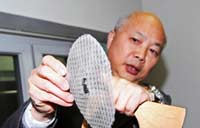Clearing the air
The device can capture PM10, PM2.5, PM1 and smaller particles, Van de Vorle claims.
Roosegaarde says it does not pull in fog, which might interfere with precipitation.
But while some suggest the technology appears to indicate a paradigm shift that will blue leaden skies, Roosegaarde himself believes it's no panacea.
"It's not the answer to smog," he says.
"But it's making people aware there are solutions. The solution to smog is human - not technological. We should change the way we behave."
That means more than developing sustainable transportation, energy grids and industry, he believes.
"There are no shortcuts in this world," he says.
"Instead, we need a big shift."
That's more psychological than technological, Roosegaarde explains.
He says people need to live according to the idea: "On Earth, there are no passengers. Only crew. So, we need to start to change and redesign our behavior."
Van de Vorle says the question of whether the device could end smog is difficult to answer but isn't the entire question.
"That's a much wider discussion," she says.
"We should have a complete discussion about addressing the causes of pollution instead of only cleaning the air. Smog is just a part of the global pollution problem."
But it's still a promising weapon in the arsenal, she says.
"This technology will be able to purify the air of a complete park or a city. We're convinced that we will be able to achieve that in the future," Van de Vorle says.
"We'll take the first steps in the next year. After that, we can figure out how long it will take until it can clear the smog from an entire city."
The company is working in other cities, but many don't want to reveal that because they consider their smog problems "sensitive", she says.
"This is a revolutionary technology," Van de Vorle says.
"It's a platform technology. We make this technique accessible for all possible markets to purify the air we breathe."


















